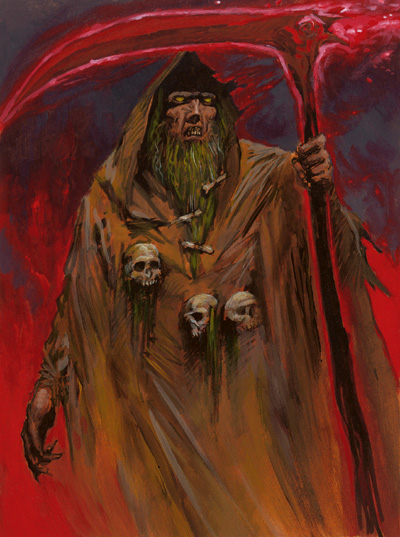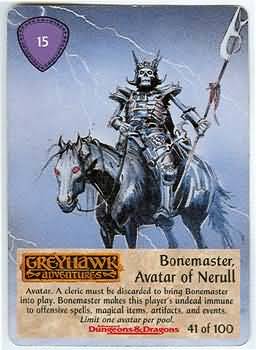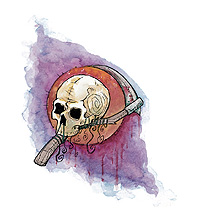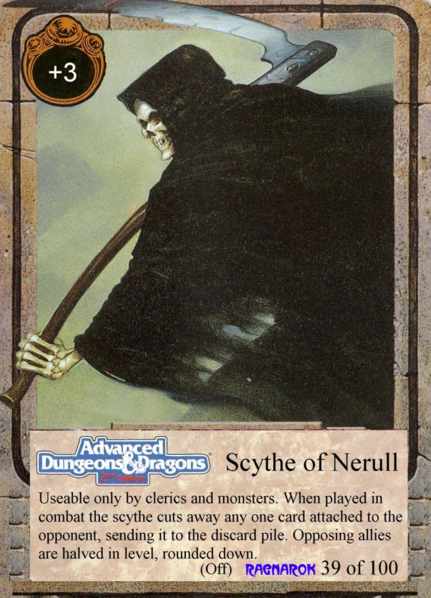
Nerull (Major Deity)

AL: Neutral evil
WAL: Any evil
SoC: Death,
Darkness, Underworld
SY: Skull and scythe
CR: Rust-red
PN: Tarterus
Nerull, the patron deity
of covert activity, is known as the
Reaper, Foe of all Good,
Hater of Life, Bringer of Darkness,
King of all Gloom, and Reaper
of Flesh. He is the deity of
all who embrace evil for
enjoyment or gain. Many evil
humans and some humanoids
pay homage to Nerull. In
wicked lands, such as the
Great Kingdom, temples of
Nerull operate openly. Elsewhere
his temples operate
secretly in subterranean
vaults. Services to Nerull are
conducted in darkness, with
a litany glorifying death and
suffering. Blood sacrifices
are common. Altars are made
of rust-colored stoen; service
pieces are copper and malachite.
Nerull's Avatar

HD: 20
THACO: 12
SpA: CL/MU 14/14
MV: 15" / 45"
AC: -4
hp: 90
#AT: 1
Dmg: 5-30
MR: 50%
SZ: M
| S: 15 | I: 16 | W: 19 |
| D: 18 | C: 18 | CH: 14 |
| Com: | - | - |

Nerull appears as a skeletal
figure with dull rust-red
skin. His skull-like head
has locks of dark green, ropey
hair. His eyes are a green,
suggesting verdigris; his talons
and teeth are the same hue.
He wears a black cowl and carries
the Life Cutter, a red-veined
sablewood staff. He <>
appears on the Prime Material
Plane only during darkness.
Nerull can fly. All senses--including
infravision <>
and ultravision--are twice
as effective as the human norm. <>
Furthermore, his vision
cannot be obscured by darkness or
clouds, magical or otherwise.
This makes him, for all practical
purposes, immune to surprise,
except through some
extraordinary means. Once
per day, Nerull can summon
three demodands of the same
type. THe summoning takes
three segments, and the
creatures appear 1d8 segments
later. The creatures serve
willingly.
His most common avatar is
struck only by weapons of +2
or better weapons, and has
the abilities of a 17th level
thief.
Nerull generally carries
one or more cursed magical
items. Among his favorites
are a necklace of strangulation,
a [bag of devouring], a
[rug of smothering], and a [poisonous cloak].
Sometimes, he simply leaves
these items lying about
where they can hurt the
greedy or unwary, but usu. he
uses these items offensively,
preferably from behind.

The Life Cutter is actually
a scythe. At Nerull's command
a huge blade of red force
extends from its tip. The
blade is equal to a +5 weapon.
With it, Nerull can sweep a
180-degree arc 10 feet long
and 2 feet deep. Each creature
within the arc is subject
to attack (normal to hit roll required).
Even creatures in Astral,
Ethereal, or gaseous form are affected.
Victims struck must save
vs. death or expire instantly;
those saving suffer 5d6
damage.
Creatures from, or dwaring
energy from, the Positive Material
Plane suffer double damage.
Undead struck by the blade crumble to dust unless
they, too, save vs. Death.
The double-damage and death
effects are negated by a successful
magic resistance roll, but
the base damage is not.
-
Nerull's Clerics
AL: Any evil
RA: Rust-red or black garments
AEx: 5%
WPN: staff*, plus specials
SPH: Astral, Combat, Divination
(minor), Healing, Guardian, Necromantic, Sun (reversed)
SPL: none
ADD: ebony tendrils,
[command], [pass without trace], [sanctuary], [hold person],
[obscurement], [withdraw],
[dispel magic], [meld into stone], [quest], [part water],
[aerial servant], [word
of recall], [succor]
Clerics of Nerull dress in
rust-red or black garments. All
carry the skull and scythe
either openly or cleverly hidden
somewhere on their persons.
All of Nerull's clerics are
trained to be alert, and
are surprised only on a roll of 1. At
1st level, clerics are trained
to USE small sickles (equal to
daggers). At 5th level they
learn to use scythe-like pole
arms (treat as hook-fauchards).
These weapon proficiencies
are in addition to the cleric's
normal weapons. Nerull's
clerics never share secrets
or confide in anyone.
Additional Spell
Ebony
Tendrils
(Conjuration/Summoning)
|
|
|
|
|
|
|
|
|
|
|
|
|
|
|
|
|
|
Effect:
This spell summons a lump of blackness five feet in diameter
with
four 10-foot arms radiating from it, 90 degrees
apart.
Touching the central lump causes death unless a
save
vs. Death is made. The arms attack with the same
chance
to hit as the cleric casting the spell, inflicting
d10+2
HP of corrosive and constriction damage.
Creatures
struck have one chance to break free, which is
the
same ast eh chance to open a door. (If the chance to open
doors
is unknown, assume that smaller than man-sized
creatures
escape on the roll of a 1 on 1d6, man-sized creatures
on
a roll of 1 or 2 on 1d6, and larger than man-sized
creatures
on a 1,2, or 3 on 1d).
The
round after scoring a hit, an arm retracts into the
central
lump, where the victim in its grasp must save vs.
Death.
Thereafter, the victim is held fast, and continues to
suffer
corrosion and constriction damage, but continued
contact
with the lump does not cause additional saves vs.
death.
Broken arms retract into the central lump without
making
further attacks. Arms holding dead creatures continue
to
hold them until the spell duration expires.
MC:
Nerull's unholy symbol (the skull and scythe) and a small, rusty iron ball.
Quote:
Originally posted by
Upper_Krust
Hi Gary mate! ![]()
[snip]
1. What kind of beast was
Putriptoq (Nerull-Infestix' steed)?

The steed that Infestix
rode was never stated out by me, but I envisaged it as a sort of a cross
between a nightmare and one of the mounts ridden by the Four Horsemen of
the Apocalypse.
Quote:
Originally posted by
Upper_Krust
Hello again Col_Pladoh mate! ![]()
[gross snippage]

Thanks again.
Welcome Upper_Krust ![]()
You are correct in supposing that I was not considering a Biblical type of treatment of the Four Horsemen, so War and Famine were not represented by that nasty lot headed up by Nerull.
Ciao,
Gary

Erythnul was my conception,
and it was inspired by need in the pantheon being created, and the "Demon
of Blood & Seed" from Hindu mythology provided the conceptual basis
for one of his capabilities.
Quote:
Originally Posted by med
stud
Hi Gary (and merry christmas
and happy new year!!)
I was wondering something
about the names of Erythnul and Nerull; Erythno means red or something
like that in latin or greek, and nero means black. Did you name Erythnull
and Nerull with that in mind?

Yuletide Greetings, Med
Stud,
You are on target with the above. Erythnul was conceived of a bloody, Nerull as dark and against life.
Cheers,
Gary
*template***template*